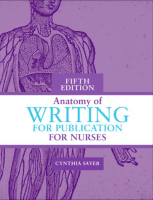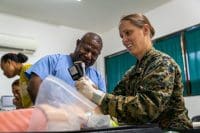The world stands still for no one, and nurses know first-hand how dramatically health care has changed over the years. Today, higher patient acuity, rapidly changing technology, and increased workloads are part and parcel of acute care nursing; and though it should come as no surprise, the same can be said for school nursing.
To support school nurses in their quest to ensure student health and safety, the ANA Board of Directors recently approved a comprehensive position statement that addresses the role and responsibilities of school nurses. The statement also outlines strategies to achieve high-quality health care in this increasingly complex setting, including requiring a minimum of one school nurse for 750, essentially healthy, students.
“Many people just think of the school nurse as the person who determines whether the kid with the bellyache needs to be sent home,” says Cheryl Resha, EdD, RN, a member of ANA’s Congress on Nursing Practice and Economics work group, which developed the policy statement with wide-ranging input from school nurses, other RNs, and key nurse groups.
“If school nursing was only that easy. Schools are much different places than they were in the days of Lillian Wald [considered the “founder” of school nursing in the early 1900s] and even 10, 15 years ago,” says Resha, also a member of the National Association of School Nurses (NASN) and the Connecticut Nurses Association.
School nurses now contend with everything from ensuring the well-being of numerous students with chronic or acute healthcare needs to developing and implementing plans for emergencies, including natural disasters and school violence. In many ways, they are like the small town family doctor who must meet the urgent and wellness needs of an entire community.
The ANA position statement, Assuring Safe, High Quality Health Care in Pre-K through 12 Educational Settings, was developed to capture the breadth and depth of the school nurse role, says Sue Foster, MSN, RN, a former school nurse and member of the ANA work group.
“For me, the statement addresses three major pieces,” says Foster, a nursing consultant for children with special needs and a Colorado Nurses Association member. “Rather than being disease- or illness-specific, it’s purposely a broad statement that speaks to all school personnel and addresses the healthcare needs of all schoolchildren.
“It also shows ANA’s clear support for a 1-to-750 ratio—with the student number reduced if children have more complex physical or mental health needs. And, it clarifies the issues of delegation and lines of authority that school nurses deal with.”
NASN President Sue Will, RN, MPH, NCSN, FNASN, says the document is thorough and strengthens the case for having RNs in schools.
“If parents have a child with a chronic health problem, they really appreciate the care and monitoring that school nurses provide,” Will says. “But if parents have children who are usually healthy, they may not understand the importance of our role.”
Inside the classroom
Between 12 and 18 million children and adolescents in the United States are affected by chronic diseases and other chronic health conditions, the ANA document notes. These conditions include diabetes, cerebral palsy, asthma, and developmental disabilities. Looking at asthma alone, it affects more than 6 million children and is the leading cause of school absenteeism.
The ANA statement also points out that children with complex healthcare needs come to school with a variety of medical devices, from insulin pumps to gastromy tubes, and it’s the school nurses’ role to develop effective care plans for them in collaboration with students’ healthcare providers and families.
Beyond addressing special health needs, the school nurse’s role includes screenings and referrals, health education, monitoring of communicable diseases, and a range of leadership and assessment activities.
School nurses often are the first to identify students with physical or mental health needs through screening and drop-in visits, because students “often view the school nurse office as a safe place to go to discuss problems,” says Resha, a health promotion consultant for the Connecticut education department.
By the numbers
According to a 2004 NASN report quoted in the ANA statement, the school nurse-to-student ratio varies from state to state—with Vermont at 1 to 305 and Utah at 1 to 4,952.
The ANA work group set the ratio at 1 to 750, which is a number supported by NASN and other school-
oriented groups, as well as the U.S. Department of Health and Human Services’ Healthy People 2010. The ultimate goal is to have at least one nurse in every school.
“Although we realize that the mission of a school district is education, we believe every school should have a school nurse to ensure that children are healthy and safe so they can learn,” says Will, who now works at an alternative learning program with 150 students, but has overseen the care of as many as 2,000. A recent survey by NASN shows that 75.1% of the nation’s public schools have a school nurse on site at least weekly, Will says. And that’s progress.
One state that enacted a law requiring that every school building has a school nurse is Delaware.
Delaware School Nurses Association (DSNA) promoted the 1979 law, which includes a mechanism whereby the state generally funds approximately 70% of the required school nurse salary and the district pays the remaining 30%, according to Linda Wolfe, MEd, RN, NCSN, a former NASN president and school nurse consultant for Delaware. A state formula also determines the ultimate number of school nurse positions in the state, which typically works out to a nurse-to-student ratio of 1 to 750.
“We are very fortunate to have that law in place, although we’d like to have more school nurse positions,” says DSNA President Rebecca King, MSN, RN, NCSN. She’s currently the school nurse at a suburban elementary school with 876 students.
Even though she works at one school, her workload is rigorous. For example, at the beginning of every year, King assesses about 100 new children, reviewing their physicals and immunization records. She also routinely performs hearing, vision, and scoliosis screenings.
“I also see a fair number of children with asthma, and I generally have at least one or two children with type 1 diabetes every year,” King says. “And no matter if you have 200 or 2,000 students, the school nurse is responsible for developing and evaluating school crises plans.”
King notes that when she worked at a city school with 350 students, her job was equally challenging because students typically had more complex physical, emotional, and social needs.
Another important piece of the school nurse equation in Delaware is that state nursing practice regulations restrict school nurses from delegating tasks, and King and Wolfe wouldn’t want it any other way. When school nurses cannot be present, the district brings in substitute RNs, King says.
To delegate or not to delegate
Given the resource-poor environment of many school districts, however, ANA and the work group determined that the position statement also needed to address the issue of delegation, says Cynthia Haney, JD, senior policy fellow in ANA’s Department of Nursing Practice and Policy.
“The school nurse cannot be everywhere at once, of course,” Haney says. “So a system must be in place to enhance and extend the nurse’s effectiveness and availability.” The statement calls for the “daily availability” of a school nurse, which means that he or she must be on site a portion of the day and have an effective plan in place to either provide immediate consultation or permit the implementation of prearranged protocols, should the need to delegate arise.
Therefore, ANA supports the development and dissemination of instructional curricula to help school nurses educate non-healthcare school personnel to perform tasks competently.
“The ANA statement really talks about what it means to delegate and the training needed to ensure safe delegation,” Resha says. “It’s important that nurses know the ability of the person to whom they delegate, whether that person is comfortable taking on the task, and what’s safe to delegate.”
Foster adds that the lines of authority within schools are sometimes blurred—which can create problems for nurses when school administrators want to implement policies that conflict with nurses’ scope of practice regulations particular to each state.
“School nurses are like triangles in a circle,” Foster says. “We’re different from other school staff because of our professional standards and regulations. This position statement hopefully will provide school nurses with the support—and school administrators with the understanding—they need to create safe environments for all students nationwide.”
The ANA position statement is available online at www.nursingworld.org, under “position statements.”
Susan Trossman, RN, is the senior reporter in ANA’s Communications Department.


















